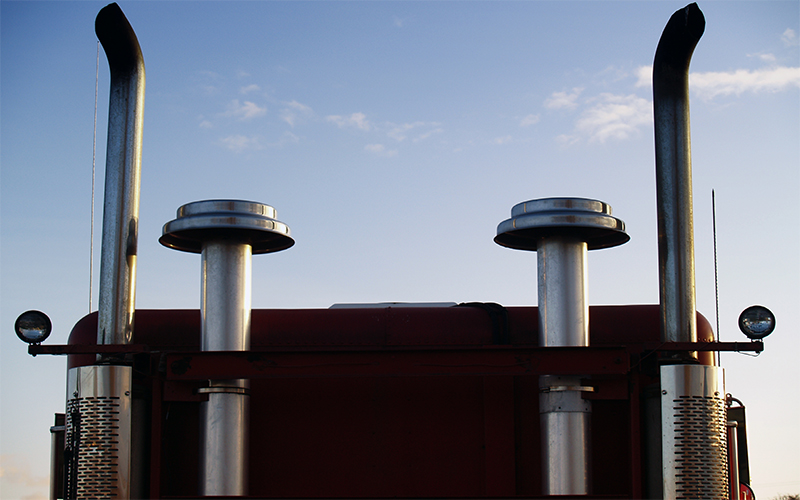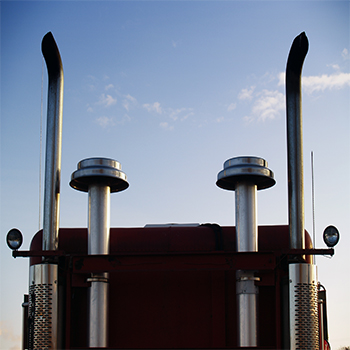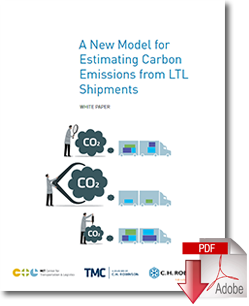US Regulators Unveil Final Rule on Truck Emissions

The Obama administration today issued aggressive new emissions standards for heavy-duty trucks, new rules that are expected to achieve better fuel efficiency and a bigger cut in pollution than the version first proposed last year.
Across America, companies have reason today to celebrate an important step to drive cost and emissions out of their supply chain.
The U.S. EPA and U.S. Department of Transportation unveiled new fuel efficiency and greenhouse gas standards for heavy trucks.
Once fully implemented, the new standards will cut over a billion tons of climate pollution and save hundreds of millions of dollars by 2035.
Every business in America stands to benefit.
Why? Because every business in America relies, in some form, on trucking services. Product manufacturers need trucks to get goods to market. Service and knowledge companies depend on trucks to deliver equipment and supplies. Retailers utilize trucks in distribution.
Retailers and consumer brands are among the top winners of strong fuel efficiency standards, as these companies account for a lot of freight movement.
Companies that have undertaken detailed carbon footprint analysis often find, as Ben & Jerry’s did, that freight transportation can account for upwards of 17% of their total impact.
The new fuel standard means continued progress in tackling this significant source of emissions. This progress will reveal itself in lower carbon footprints for every product brought to market. It will be apparent through lower freight and fuel surcharge fees – saving large consumer brands millions annually.
The standards will be increased in 2024 and 2027, resulting in final standards that will require new tractor-trailer units to emit 25% less climate pollution in 2027 than in 2017. Long-haul truck drivers will see the new efficiency technology pay back in under two years.
The new standards will drive market uptake of a number of proven fuel saving technologies. Through the Super Truck program of the U.S. Department of Energy, for example, a Daimler team developed a 12.2 MPG trucks and a Cummins and Peterbilt team developed a 10.7 MPG truck. As a group of leading technology innovators noted early this year;
“clear, stringent, long-term fuel efficiency and greenhouse gas standards” are critical to scaling emerging solutions “by creating certainty that high-quality, effective innovations will be rewarded in the marketplace.”
With the certainty of long-term standards, manufacturers will make the needed investments to introduce new engine platforms, better integrate powertrains, and take advantage of other cost-effective choices. In fact, this is just what has happened during an earlier phase of the clean truck program.
PepsiCo, Walmart, General Mills and a number of other leading companies played a critical role in securing the robust, final standards. They were drawn to advocate for strong standards because of the clean truck program’s combination of significant environmental and cost savings, and its ability to bring forward market-ready solutions.
It’s telling that these companies, which are leaders in adopting voluntary green freight best practices, were motivated to advocate for federal greenhouse gas and fuel efficiency standards too. They recognize that freight movement, which accounts for around 10% of U.S. greenhouse gases, has a critical role to play in cutting our emissions.
Making heavy trucks more fuel efficient is the single most important step to reducing freight emissions. The program announced will be crucial to build a low-carbon future that enables the free flow of freight. That is an outcome every business should celebrate.
Source: Environmental Defense Fund
3 Top Insights for LTL Carbon Emissions
1. Current models for calculating LTL carbon emissions are highly inaccurate. Many current approaches are based on truckload CO2 emissions protocols, but LTL is far more complex than full truckload. Small shipments from an average of 20 to 30 companies - a wide range of products in various packaging configurations, ranging from 100 to 10,000 pounds - may be consolidated on a single truck. Load factors from LTL operations are often significantly lower than those associated with truckload transportation, and this disparity can have a notable impact on emissions estimates.
2. Two new approaches offer more accurate estimates. The research led to two new methods of calculating LTL carbon emissions. The detailed model, largely of interest to the LTL carrier community, requires detailed dimensional data about the freight that shippers often do not gather , as well as information about a carrier’s network infrastructure (terminals, lanes). Instructions for using the detailed model are available at the MIT CTL website. The simplified model can be applied to most shipper operations to provide baseline estimates considering network averages obtained in this research (see page 11 for more information).
3. The models developed by the MIT CTL research are freely available to every logistics player. The work cited in this white paper provides a platform for future research and makes a significant contribution to our understanding of freight transportation’s carbon footprint. If adopted, these models can help the industry to create a more precise account of LTL carbon emissions.
Related: C.H. Robinson and MIT Develop New Model for Carbon Emissions

Article Topics
Environmental Defense Fund News & Resources
Environmental Defense Fund report makes the case for zero-emissions vehicles purchases A Look at Green Freight and Logistics EDF unveils crowdsourced platform to accelerate corporate sustainability US Regulators Unveil Final Rule on Truck Emissions Accelerating the Shift to More Efficient Trucks Green Freight Handbook Climate Impacts of Heavy Duty Natural Gas Trucks More Environmental Defense FundLatest in Supply Chain
Baltimore Bridge Collapse: Impact on Freight Navigating TIm Cook Says Apple Plans to Increase Investments in Vietnam Amazon Logistics’ Growth Shakes Up Shipping Industry in 2023 Spotlight Startup: Cart.com is Reimagining Logistics Walmart and Swisslog Expand Partnership with New Texas Facility Nissan Channels Tesla With Its Latest Manufacturing Process Taking Stock of Today’s Robotics Market and What the Future Holds More Supply Chain














